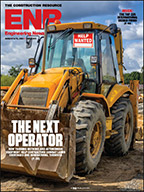
The appeal of renting equipment and renting for longer terms is increasing among contractors because of "the uncertainty created by the economic downturn of the last few years and an unwillingness to commit to purchases, given the work situation," says Sidney Sexson, senior vice president at Wells Fargo Equipment Finance, Tempe, Ariz.
Scarce new development activity amid tight lending conditions has ratcheted up the rivalry among job-hungry contractors, leaving more firms vying for fewer projects. The increased competition has narrowed already slim bidding margins, forcing contractors to eke out a financial edge wherever possible. For some firms, that has meant renting rather than buying. Equipment rentals allow contractors to shift downtime risk while trimming expenses, including licensing, insurance, taxes and debt, among others.
The U.S. rental business grew an estimated 18.6% in 2011, according to the Associated Equipment Manufacturers, a Milwaukee-based industry trade group. This year, North American equipment rentals are expected to generate $33.5 billion in revenue, an increase of 6.9% and more than three times the expected growth rate of the U.S. economy, says the Moline, Ill.-based American Rental Association. Rentals offer a flexible, safe solution as the economy makes a jagged recovery.
"We are a big proponent of renting due to depreciation, storage, transportation, maintenance and upkeep costs," says Paul Dudzinski, project director for McCarthy Building Cos.' Southwest region. "We own only about 15% of our own equipment and rent the rest as needed."
The recession prompted many contractors to thin their fleets in order to lower overhead and generate cash. Strong foreign demand has also spurred divestitures, creating rich auction paydays for late model equipment.
"We sold $10 million of equipment in the last six months due to low utilization and the expense of ownership," says Paddy Murphy, general manager for construction at Aggregate Industries' Southwest region. "It's important to get maximum use out of a piece of equipment in order to effectively manage costs."
Maintenance Blues
While rentals account for only 1% to 3% of total project costs, experts say, a non-functioning machine can bring a jobsite to a standstill. An idle crew waiting for a replacement machine or repairs can add unexpected costs that skew project profitability. "Margins are so tight that we can't afford to prorate our productivity. It wouldn't make us competitive," Dudzinski says. "Maintenance is a big part of our decision. I don't always go with bottom dollar on a piece of equipment."
Machine reliability is crucial for steady work progress; speedy service and repairs often weigh heavily in deciding whether to rent or own. Remote jobsites can add a tricky twist, however.
"We have a project in North Dakota where it can take two to three weeks to get a dealer to work on something," says Rick Ewing, equipment coordinator for Las Vegas Paving Corp., a 54-year-old privately owned, $300-million-a-year heavy civil contractor. "As a result, we send out our newest equipment because we don't want something that breaks down."





Post a comment to this article
Report Abusive Comment